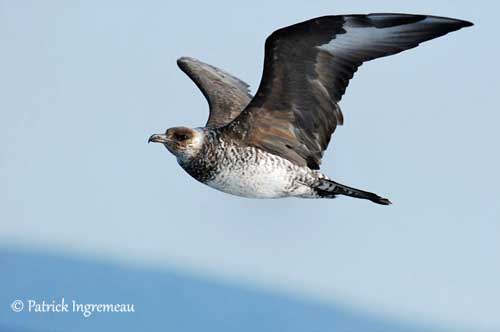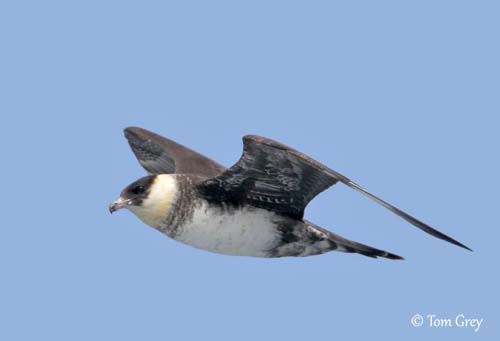
Fr: Labbe pomarin
All : Spatelraubmöwe
Esp: Págalo Pomarino
Ital : Stercorario mezzano
Nd: Middelste Jager
Sd: Bredstjärtad lab
Russe: Средний поморник
Port: Mandrião-pomarino
Photographers:
Tom Grey
Tom Grey's Bird Pictures
Patrick Ingremeau
TAMANDUA
René Lortie :
http://rlortie.ca/
Text by Nicole Bouglouan
Sources:
HANDBOOK OF THE BIRDS OF THE WORLD Vol 3 by Josep del Hoyo-Andrew Elliott-Jordi Sargatal - Lynx Edicions - ISBN : 8487334202
SKUAS AND JAEGERS by Klaus Malling Olsen and Hans Larsson - Pica Press Sussex,
ISBN: 1873403461
Avibase (Lepage Denis)
BirdLife International (BirdLife International)
Bird Web (Seattle Audubon Society)
Wikipedia, the free encyclopaedia
Pomarine Skua or Jaeger
Stercorarius pomarinus
Charadriiforme Order – Stercorariidae Family
BIOMETRICS:
Length: 46-51 cm, including tail streamers of about 10-11 cm
Wingspan: 125-138 cm
Weight: 550-850 g
DESCRIPTION:
The Pomarine Skua or Jaeger is the largest species of genus Stercorarius. There are two morphs, pale and dark. Pale morph predominates while dark morph is about 5-20% of all populations.
The adult in pale morph has blackish-brown upperparts with several pale primary shafts on the upperwing.
On the underparts, neck, upperbreast, body sides, lower belly and vent are variably dark brown with more or less distinct barring. Underwing is dark, but we can see a conspicuous white panel at base of primary flight feathers. The tail is dark with longer central tail streamers of up to 10-11 cm.
The head is blackish-brown until the base of lower mandible, including rear ear-coverts and middle part of the hindneck. Chin, throat and cheeks are whitish. From head side to hindneck, and sometimes upperbreast, feathers are yellow to deep brownish-yellow. There are sometimes browner shaft-streaks.
The heavy bill is greyish-brown to pale yellow-brown with blackish tip. Eyes are dark brown. Legs and webbed feet are blackish.

The Pomarine Skua or Jaeger in dark morph has whole blackish-brown plumage, sometimes washed purple. Neck sides can be tinged bronzy-brownish. On the wings, the pale area is usually smaller.
The female is similar, but she has shorter tail projection than male. She always has breast band and dark barring on flanks, whereas male has usually less conspicuous pattern, with breast band lacking in 20% of birds.
The tail streamers can be lost during summer. Winter plumage is variable, often with barred rump.
Juvenile and immature show variable plumage too, but they have the white wing panel and barred plumage with paler rump.
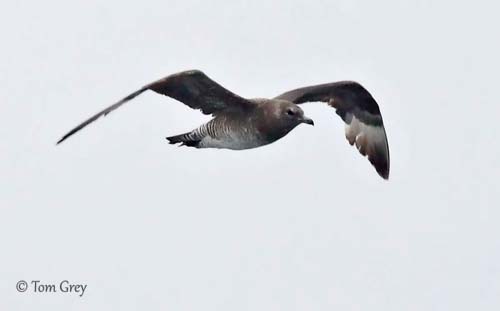
VOICE: SOUNDS BY XENO-CANTO
The Pomarine Skua or Jaeger is silent outside the breeding season, but juveniles may give low barking sounds in post-breeding period.
Adult on breeding site utters short low, harsh calls. When at sea accompanying trawlers, they may utter some sharp “which-yew, which-yew, week, week, week…”
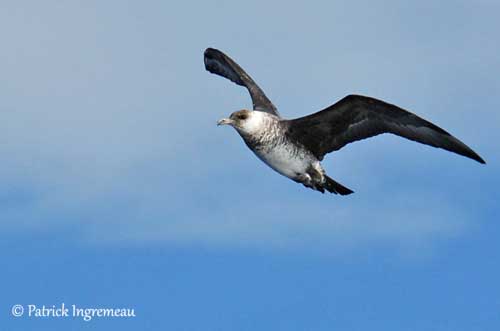
HABITAT:
The Pomarine Skua or Jaeger is pelagic outside the breeding season. It remains mainly near coasts, especially in upwelling tropical and subtropical regions.
It breeds on Arctic tundra, on low moss tundra with pools and areas with hummocks in moist bogs.
RANGE:
The Pomarine Skua or Jaeger is found in Tundra of N Russia, N Alaska and N Canada.
It winters at sea and close to the coasts of all continents, but mainly between tropic of Cancer and equator, and around the Australian continent.
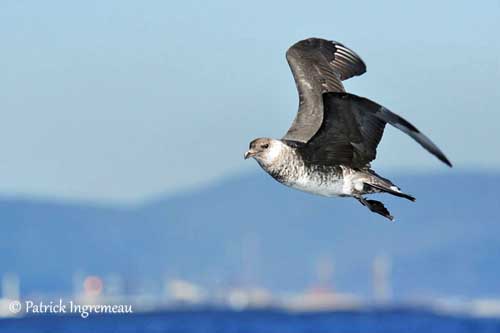
BEHAVIOUR:
The Pomarine Skua or Jaeger is a predator for lemmings, its main food during the breeding season. It catches them (and other rodents) from the ground, and even digs open their burrows. Lemmings are about 90% of the diet at this period. It also takes birds’ eggs, young waders and gamebirds, fish and carrion.
It feeds mainly on fish in winter, spending most time at sea. It performs kleptoparasitism, kills small seabirds such as Red-necked Phalaropes, abundant in these regions. It also takes carrion and carcasses around piers and boats.

The density of the breeding population is closely related to density of lemmings. This is the only species which does not show mate and site fidelity every year. This behaviour is probably in response to fluctuation of lemming availability.
During the breeding season, the Pomarine Skua or Jaeger is highly territorial when breeding on tundra. The adult flaps the wings higher up and more slowly than usually, while producing nasal calls. It also may fly towards the intruder, gliding with wings held in V-shape to scare the opponent.
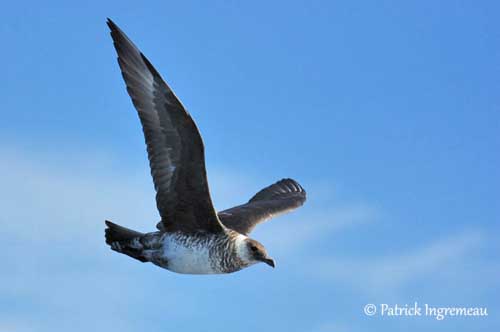
Some displays are reported before to prepare the nest scrape. Both adults perform circular displays accompanied by much squeaking.
The Pomarine Skua or Jaeger travels in flocks during migrations. They migrate southwards to winter in low latitude seas, and mainly N of equator. They travel extensively over land too. They leave the breeding grounds in September and return in May, often in small flocks. Immature birds remain in temperate areas in summer.
FLIGHT:
The Pomarine Skua or Jaeger performs powerful flight. It soars easily. The flight is direct with relatively slow wingbeats, rather stiff and shallow.
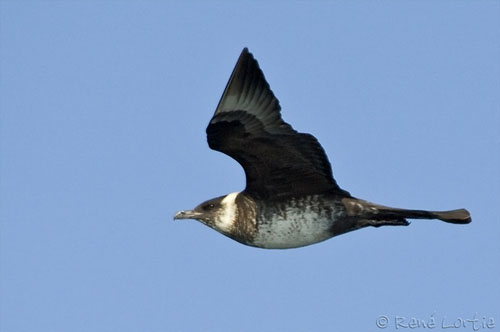
REPRODUCTION:
The breeding season starts in June.
The Pomarine Skua or Jaeger breeds in widely scattered pairs on marshy tundra. The nest-site is established in low moss, often in grassy hummock along marshy areas or freshwater pools. The nest is an unlined scrape on the ground made by both adults.
The female lays two eggs, and both parents incubate during 25-27 days. Chicks are covered in dark grey-brown down. They leave the nest only 2-4 days after hatching, but they remain in the vicinity of the nest. They are fed by both adults. They fledge about 31-35 days after hatching, and are able to fly.
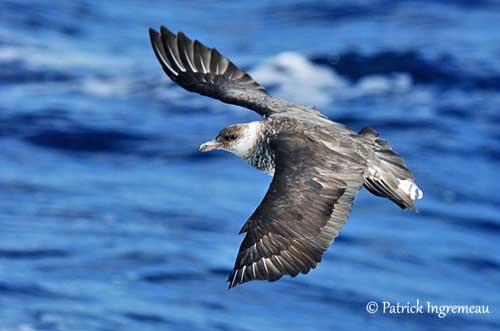
DIET:
The Pomarine Skua or Jaeger highly depends on lemming abundance during the breeding season. It also takes birds’ eggs, young waders and gamebirds.
During winter, it feeds mostly on fish, small seabirds and carrion.
PROTECTION / THREATS / STATUS:
The Pomarine Skua or Jaeger has stable populations with no evidence for any declines or potential threats. The species is not currently threatened.
